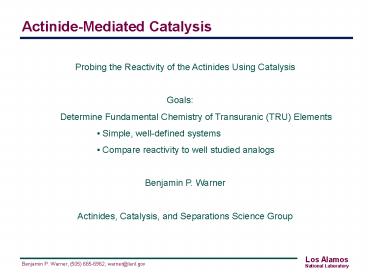Probing the Reactivity of the Actinides Using Catalysis - PowerPoint PPT Presentation
1 / 20
Title:
Probing the Reactivity of the Actinides Using Catalysis
Description:
... catalyze MPV - Np(III) is oxidized by ketones, but not by iso ... coordination, but ketones and alcohols oxidize U(III) to U(IV), and ketones oxidize Np(III) ... – PowerPoint PPT presentation
Number of Views:42
Avg rating:3.0/5.0
Title: Probing the Reactivity of the Actinides Using Catalysis
1
Probing the Reactivity of the Actinides Using
Catalysis Goals Determine Fundamental
Chemistry of Transuranic (TRU) Elements
Simple, well-defined systems Compare
reactivity to well studied analogs Benjamin P.
Warner Actinides, Catalysis, and Separations
Science Group
2
Outline Why should we care about reactions of
transuranic elements? What is involved in
performing transuranic chemistry? Studies of
metal-ligand coordination reactions Reactivity
studies Combinatorial approach
3
Plutonium and other actinides contact organic
materials. Processing Phosphates, Amides,
Ketones, Ammonium Salts Waste Forms
Carbohydrates, Halocarbons, Hydrocarbons,
Siloxanes Health Effects Phosphates, Amides
(DM Taylor, J. Alloys and Comp. 271-273, 1998,
6-10.)
ion exchange
combustibles
chelation
4
- Radiolysis generates small molecule reagents,
i.e. H2 and H2O2 - Plutonium radiolysis of water can generate 1
mol H2O2 per day - Radiation damage is significant
- Chemical activity has been shown to be
significant - Claycamp and Luo, Radiation Research, 137,
1994, 114-117. - Pu(III) is 4.8x more active than Fe(III)
in catalyzing ascorbate oxidation by H2O2 - Pu(III) is comparable to Fe(III) in
inducing DNA oxidative stress - (measured by 8-oxoguanine formation and
thymine glycol formation) - Questions
- What is the reactivity of Pu ?
- How can it be understood in relation to other
elements ? - What are the chemical effects v. the radiological
effects ?
5
Simple f-element compounds are known to be
catalysts
R Yield () Ph 62 10 4-NO2C6H4 90
0 c-C6H11 68 13 COOEt 36 41
X.G. Fang, J.G. Watkin, B.P. Warner, Tetrahedron
Lett. 41, 2000, 447-449.
6
Simple f-element compounds are known to be
catalysts
79 71
86 49
LnCl3 PrCl3 GdCl3 DyCl3 ErCl3
LuCl3 Yield () 1 2 42
54 62
X.G. Fang, J.G. Watkin, B.P. Warner, Synthetic
Communication. 30, 2000, 2669-2676.
7
Simple f-element compounds are known to be
catalysts Oxidation Ph-Cl (10,000 ppm)
Ph-Cl (31 ppm) CO2 GJ Hutchings, CS
Heneghan, ID Hudson, SH Taylor, Nature, 384,
1996, 341-342. Hydrolysis Catalyst
UO2(NO3)2, kcat/uncat6700, pKa UO2(NO3)2
4.2-6.1 RA Moss, K Bracken, J Zhang, Chem.
Comm., 1997, 563-564.
U3O8 / 350 C
catalyst
8
- Handling Plutonium A Non-Trivial Exercise
- Inert Atmosphere (He) Negative Pressure Glovebox
- Liquid Nitrogen and Solvent Traps for
Distillation Inside Box - Sample Removal Port for NMR Tubes
- Spectroscopy Well for IR, UV-Vis
- UV-Vis Fiber Optic
- Electrochemical Feeds
- Chilling Block
9
Ann Schake, Lonny Morgan, and an RCT remove
organo-plutonium NMR samples.
10
Preparation of Starting Materials
hexane
AnN(SiMe3)2 3.1 ArOH An(OAr)3
(Ar2,6-tBu2Ph)
Other Starting Materials Cs2PuCl6, ThCl4, UCl4
LR Avens, SG Bott, DL Clark, AP Sattelberger, JG
Watkin, BD Zwick Inorg. Chem., 1994, 33, 2248. BD
Zwick, AP Sattelberger, LR Avens, Transuranium
Organometallic Elements The Next Generation
American Chemical Society Washington D. C.,
1992, pp. 239-246.
11
Self-Exchange Reactions Associative Process
DH? 5.8 kCal/mol 3.8 kCal/mol 14.7
kCal/mol DS? -22.5 eu -26.4 eu -2.3 eu DG? 11.9
kCal/mol 11.8 kCal/mol 15.5 kCal/mol Ka
9 214 190
Binding Affinities Mirrors Process Data
12
IR Frequencies for bound and free ligands
n-free 1642 cm-1 1192 cm-1 1627 cm-1
n-bound 1580 cm-1 1149 cm-1 1564 cm-1
Dn-free 62 cm-1 43 cm-1 63 cm-1
Red shift in the CO or PO frequency
13
Elucidating the Anomalous Aryl Strengthening
Effect
?G0.192 kcal/mol
Determining Steric and Electronic Effects on
Ligation
14
Initial Examination of TRU Catalysis What
analogies can be drawn between actinides,
transition metals, lanthanides Cp2U (IV) acts
like group IV and/or lanthanides - Eisen, Marks,
Doye, Bergman Uranium (VI) allows unique
reactivity - Burns
cat Cp2UMe2, Cp2ThMe2, Cp2TiMe2, Cp2SmR,
Cp2Zr(NHAr)2
15
- An-Catalyzed Meerwein-Ponndorf-Verley Reduction
- Pu(III) catalzes MPV and Tischenko Reactions -
similar to Lanthanides
16
Pu(III)-Catalyzed Meerwein-Ponndorf-Verley
Reduction
17
- An-Catalyzed Meerwein-Ponndorf-Verley Reduction
- Th(IV), U(IV) do not catalyze MPV - similar to
Zr - U(III) does not catalyze MPV - U(III) is
oxidized by iso-propanol and ketones - (although UI2(iPrOH)4 I-)
- Np(III) does not catalyze MPV - Np(III) is
oxidized by ketones, but not by iso-propanol - U(III)/U(IV) -.631 V
- Np(III)/Np(IV) .155 V Np(III)/Np(V) .447
- Pu(III)/Pu(IV) .982 V
18
Actinides Catalyze Ketone Hydrosilation...
Catalyst Pu(N(SiMe3)2)3 3 iPrOH, An(N(SiMe3
)2)2(N(SiMe2CH2) gt4 iPrOH,
...but the Catalyst is Difficult to Generate...
Catalyst An(N(SiMe3)2)2(N(SiMe2CH2) lt4
iPrOH,
and Uranium is Still Oxidized.
U(N(SiMe3)2)3 3 iPrOH ketone appears
identical to U(N(SiMe3)2)2(N(SiMe2CH2) 4 iPrOH
ketone
An(N(SiMe3)2)2(N(SiMe2CH2)
19
Conclusions Pu mediates catalytic
reactions Pu(III) similar to Ln(III), An(IV)
similar to Group IV Carbonyl ligands bind to
Pu(III) through simple Lewis acid-base coordinati
on, but ketones and alcohols oxidize U(III) to
U(IV), and ketones oxidize Np(III) Associative
ligand self-exchange process despite large
ancillary ligands Binding affinities of three
ligands mirror those of comparable ligands in
acidic-aqueous Pu(III) process chemistry Autorad
iography used to examine combinatorial Pu reaction
20
Acknowledgements Lanthanide Catalysis Xinggao
Fang TRU Catalysis Ann Schake, Lonny
Morgan Th/U Catalysis Tony DAlessio, Rick
Broene Combinatorial Grace Mann, Cyndi Wells,
Becky Chamberlin, Mavis Lin LANL Laboratory
Directed Research and Development Program DNFSB
94-1 Core Technology Program Seaborg Institute
for Transactinium Science

